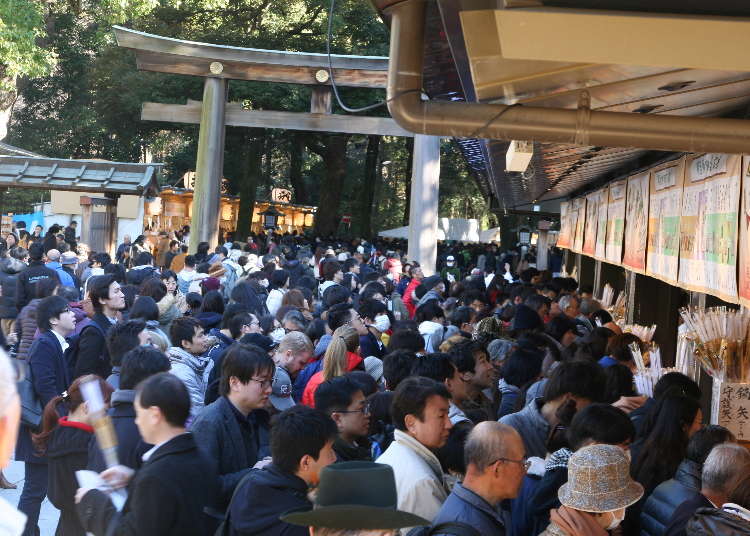
Located right next to the JR Harajuku Station, the Meiji Shrine, or Meiji Jingu in Japanese, is one of Tokyo’s most famous landmarks and an oasis of green and calm in the middle of the vast urban jungle.
Beautiful no matter which season you visit, the shrine is so large and prominent, it even enjoys its very own train station, Tokyo Metro's Meiji-jingumae. As its name suggests, Meiji Shrine is built in honor of Emperor Meiji and Empress Shoken, enshrining the souls of the royal couple.
Besides its convenient location in the heart of Tokyo, the shrine boasts both a magnificent forest surrounding the main building and the highest number of hatsumode visitors in the entire country, every single year.
Hatsumode is the first shrine visit of the year to pray for good fortune and health for the year to come. Around ten million people visit Meiji Shrine each ear, with three million visitors alone doing hatsumode between New Year’s Eve and the 3rd of January.
With such a massive crowd to expect, we were curious as to what kind of preparations and special planning the shrine would have to do to deal with all of these people – and asked Miki Fukutoku from Meiji Shrine’s General Affairs Division.
Preparation No. 1: The Wide Approach to Meiji Shrine, Planned a Hundred Years Ago!
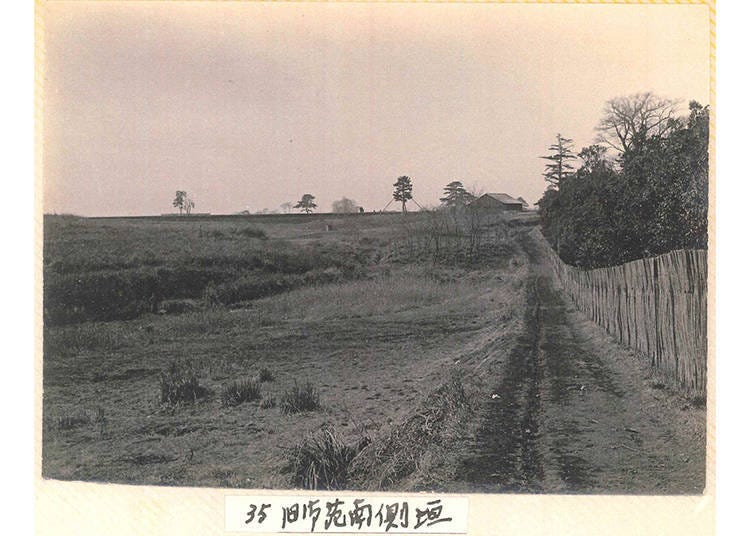
“Ever since Meiji Shrine was constructed, it was assumed that it would have a lot of visitors. As such, the approach to the shrine was deliberately made very wide to handle the flow of even a lot of people smoothly. The south entrance, facing Harajuku, is about 14.5 meters wide, while the north entrance facing Yoyogi is 11 meters wide, and the west entrance, near Sangubashi, is 7.3 meters wide. At the second torii [Shinto gate], where the northern and southern entrances meet, the approach grows to a total of 18 meters in width. There was a prediction that the most visitors would come from this side, and indeed, the majority of people enter via the north and south entrances.”
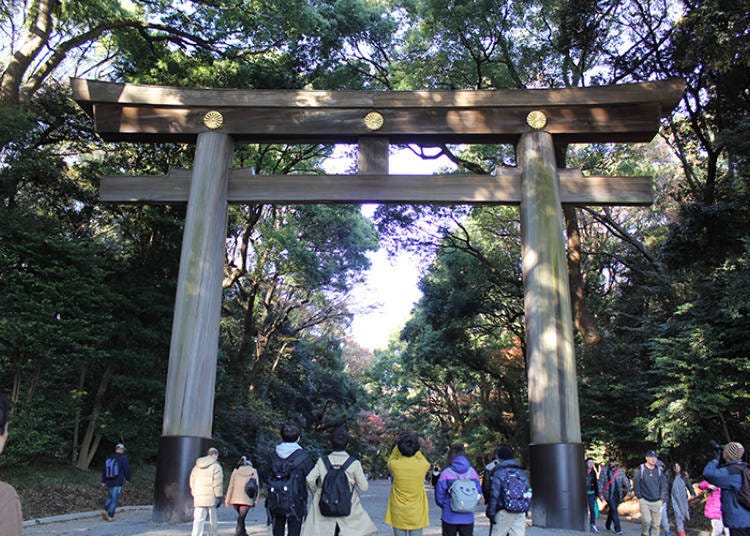
“Records from the time of Meiji Shrine’s opening to the public for general worship actually show that there always has been a huge amount of visitors. The forest around the shrine had just been planted but the shrine was designed to convey an aura of majesty and I do think that this aura was what attracted so many people even back then.”
Preparation No. 2: Zodiac Sign Goods, Prepared as Early as Summer
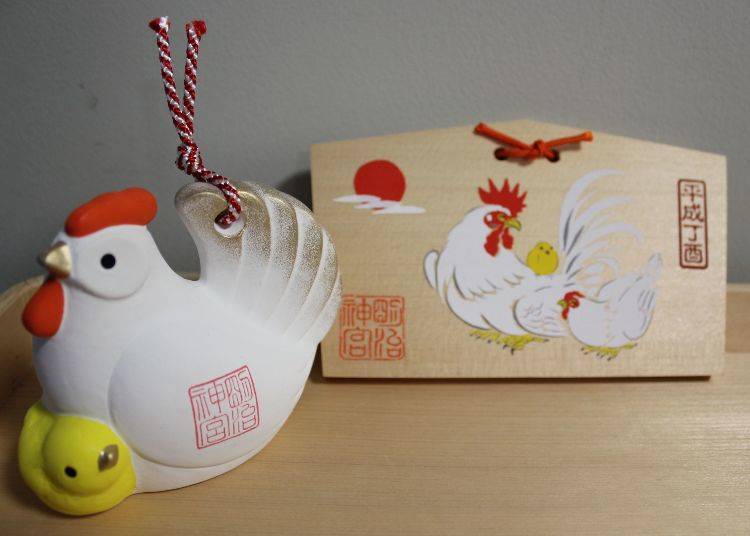
“Every year, the preparations for New Year’s starts with the making of zodiac sign-related goods. Lucky charms can be bought all around the year, of course, but special ones with the zodiac sign of the upcoming year are being made from summer on. While I cannot give too many details, there are many different prototypes made which are then corrected over and over again. Next year’s zodiac is the rooster, but the charms of Meiji Shrine are always adorned in the image of parent and child. And of course, the images are different from the rooster year 12 years ago.”

“The omamori [lucky charms] are available in a variety of colors but these are in no way gendered specifications, so simply choose whichever one you like best. Generally, there is no ‘expiration date’ on them but it is better to renew the ofuda [paper talismans inside the lucky charms] for the New Year. I think that having a lucky charm from a distant shrine or temple for many years is perfectly fine; if you wish for something, you should carry it with you until this wish is fulfilled.”
Preparation No. 3: Come December, the Shrine Grounds need to be Made Safe to Tread
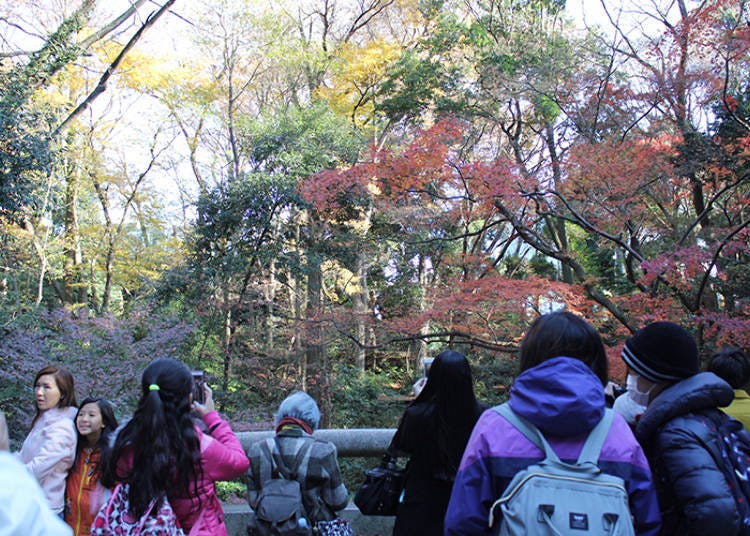
“Because the stone bridges and stairs might be slippery from rain or ice, we scatter gravel so that no one slips. Also, there are little trenches on the sides of the walkways to drain rainwater which also are covered entirely. This is all to make the shrine precincts safe. As the grounds are very wide, we do this throughout December.”
Preparation No. 4: Giant Ema and Shugoya from Late December
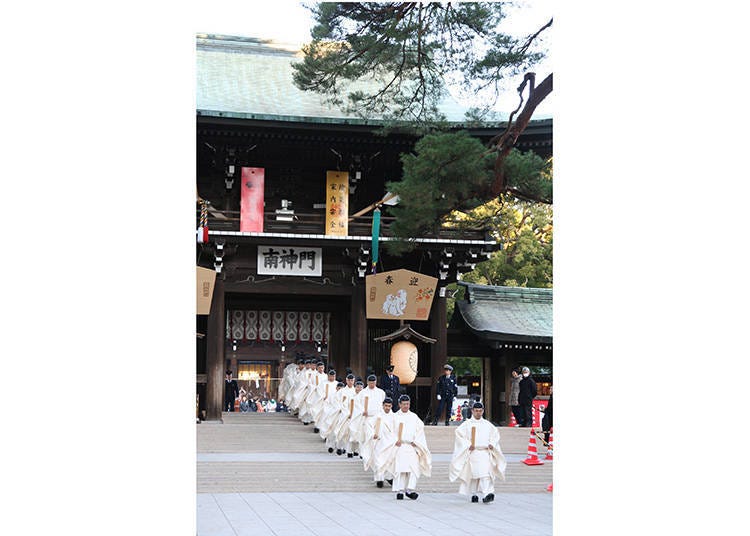
“From the end of December to mid-January, the southern torii is adorned with giant ema [wishing plaques] and large shugoya [a decorative arrow that wards off evil]. Terms such as “good fortune,” “protection from disaster,” and “safety of one’s home” will be written on the big signboard, the same wishings that are written on the shugoya.”
Preparation No. 5: Susuharai on December 28th, the “Cleaning of Soot”

“Using bamboo grass that was planted in the forest of Meiji Shrine, dusters are made and the shrine is dusted: susuharai [lit.: “soot sweeping,” annual cleaning ritual]. It is a ceremony to welcome the New Year. The first step of this ritual is to tell the kami [Shinto deity] “I am starting susuharai now,” then the Shinto priests clean the main shrine and its surroundings for 30 to 40 minutes. Of course, the main building is cleaned and dusted every day.”
Preparation No. 6: Preparing Offertory Boxes and Lucky Charm Counters
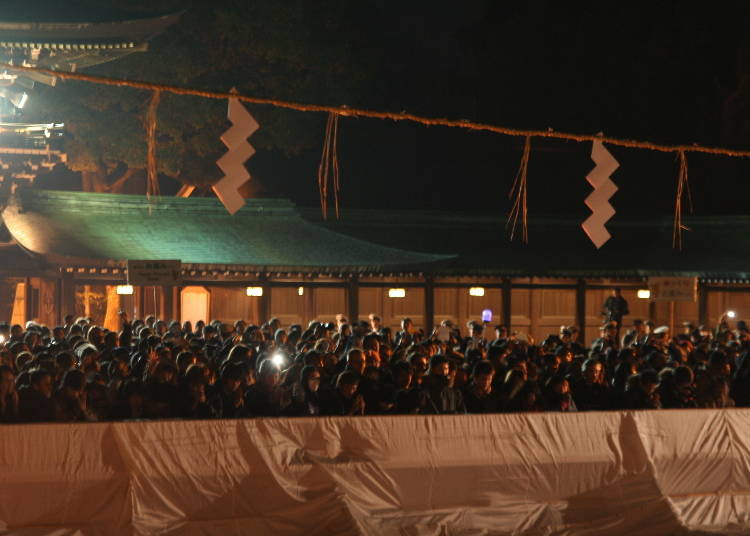
“We focus on offertory boxes and counters selling amulets and lucky charms. For the people who want to visit even after the shrine gates are closed, a box is set up to leave old charms and other festive goods.
When it gets particularly crowded, visitors are guided to enter the shrine on one side of the approach and leave it on the other up to the second torii. Additionally, we provide secure evacuation routes on the left and right, used when someone feels unwell or sick. Guidance and security is both increased and we also cooperate with the local police forces.”
Preparation No. 7: Prayer Festivals on New Year’s Eve and After
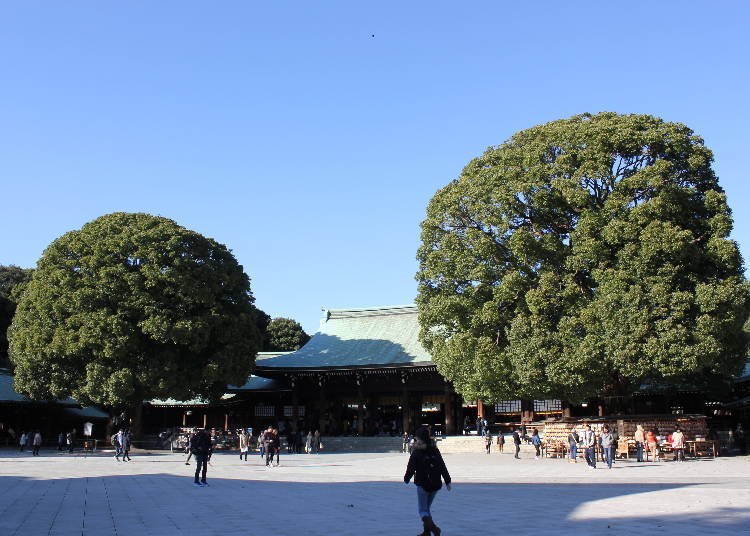
“On New Year’s Eve, representatives and associates of Meiji Shrine visit the shrine for the first prayer ceremony of the New Year, and the highest Shinto priests beat the large taiko drum exactly at midnight. This is when the people waiting in front of the shrine start the shrine visit as well. Another prayer festival is held at the kaguraden [a hall for music and dance]. A fee is required if you want to attend (10,000 yen for the first three days of New Year) but the festival is specifically held to pray for health for the entire next year. For three days this is specially held in the hall of worship and you can sound the taiko drum that welcomed the New Year.”
The Proper Way of Worship at Meiji Shrine: Make your own Vows and Revitalize
“There are certain people who treat hatsumode on New Year’s Eve like a countdown event, drinking alcohol while queueing in front of the shrine. But the meaning of visiting a shrine on New Year’s Eve and thus doing hatsumode is to do so in a ceremonious manner and to make your own vows. This is the purpose of hatsumode, hence a shrine is not a place to drink and party. However, there are places to eat and drink to warm up your body after hatsumode as well. They are called naorai but their actual purpose is to provide a place for priests to return to the worldly realm after a ceremony or a rite, and to offer sake to the kami. When you come to do hatsumode or for a festival, clean your mind and body to refresh yourself, then leave while feeling relaxed. I hope that people keep this in mind.”
There are points that one should be aware of, not only when visiting Meiji Shrine for hatsumode but also for a regular shrine visit.
“The area is not a public park; the entire area is shrine grounds. Occasionally, you can see joggers and runners but as all the walkways are shrine approaches, walk them with a calm heart. In summer, there are a lot of insects as the forest is rather deep and you’re preparing to see the kami, so wearing clothes that don’t expose too much skin is advisable.”
Hatsumode Bonus: Visiting the Nearby Power Spot, Kiyomasa Well
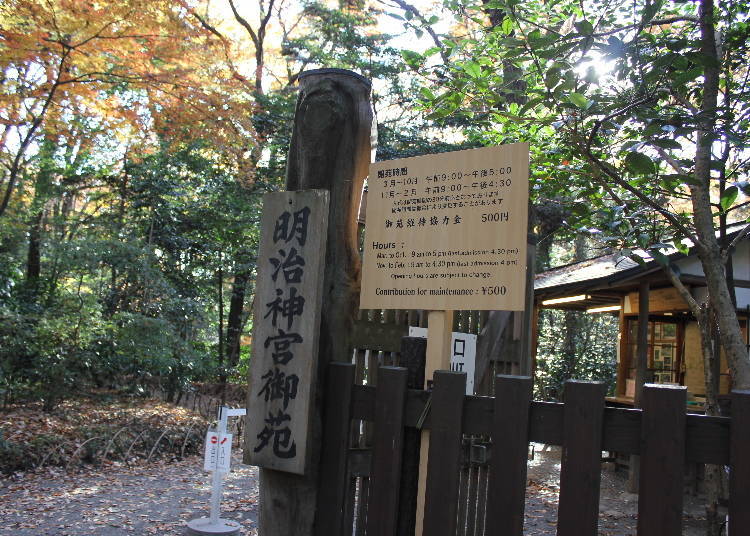
“We recommend visiting Meiji Shrine on a winter morning. The spring water of Kiyomasa Well is always between 6 and 15 degree Celsius, and the steam rising from it is a very beautiful sight. In the summer, the water feels pleasantly cool.”
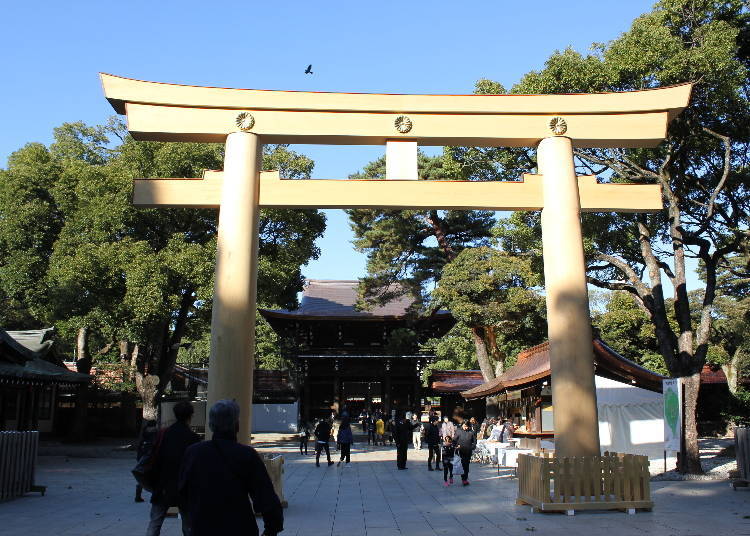
The white wooden torii right in front of the southern entrance gate was just completed on the 26th of October 2016 and is the tallest, entirely made from domestic cypress. It appears as if it is sparkling but it is not painted in any color – it is simply the natural color of the wood. 2017 will be its first hatsumode. With its size of 12 meters in height, 9.1 meters in width, and 17 meter long kasagi [the top beams of a torii], it is the biggest torii in Japan. It is made out of Taiwanese cypress.”
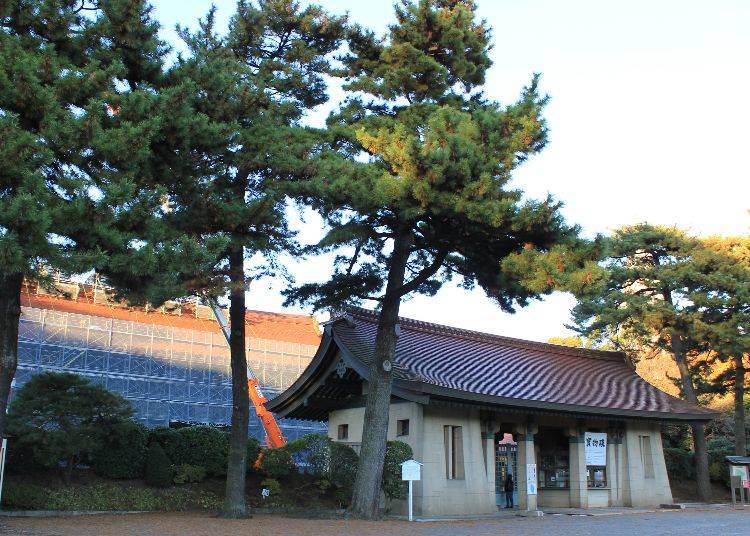
“The Treasure Museum was slightly damaged in the Tohoku earthquake of 2011 but we managed to keep it intact but eventually, we need to repair the entire building and thus it will be closed from January 10th of 2017. The treasures will be moved to a newly established facility.
It was built in 1921 and at time, there were already complications as for storing the treasures. However, since the building was designated an important cultural asset, there are a lot of restrictions. Thus, we decided to move the treasures to a new facility. Now really is the last opportunity to see the Treasure Museum in the shape it was originally built in. The ceiling is adorned with Japanese paper after the Azekurazukuri style and while the building has a distinctively Japanese atmosphere, there are no pillars in the exhibiting room and it is a very early Japanese-style construction of reinforced concrete. The carriage and desk of the Meiji Emperor are exhibited, and please feel free to relax on the spacious ground in front of the Treasure Museum.”
Meiji Shrine
http://www.meijijingu.or.jp/
-

-
Address
1-1, Yoyogikamizonocho, Shibuya-ku, Tokyo, 151-8557
View Map -
Nearest Station
Sangubashi Station (Odakyu Odawara Line)
- Phone Number 03-3379-5511
-
Address
1-1, Yoyogikamizonocho, Shibuya-ku, Tokyo, 151-8557
-
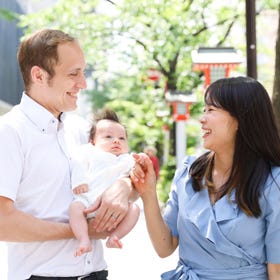 Personal Photographer~ Meiji Shrine Tokyo~Personal Photographer~ Meiji Shrine Tokyo~
Personal Photographer~ Meiji Shrine Tokyo~Personal Photographer~ Meiji Shrine Tokyo~-
Address
1-11-8 Sakuragaoka, Setagaya-ku, Tokyo, 156-0054
-
Nearest Station
Kyodo Station (Odakyu Odawara Line)
- Phone Number 090-9371-4499
-
Address
1-11-8 Sakuragaoka, Setagaya-ku, Tokyo, 156-0054
*Prices and options mentioned are subject to change.
*Unless stated otherwise, all prices include tax.
Popular Tours & Activitiess
-

Fine Dining on Rails? Japan Announces Stunning NEW 'Laview' Restaurant Train
-
Ad
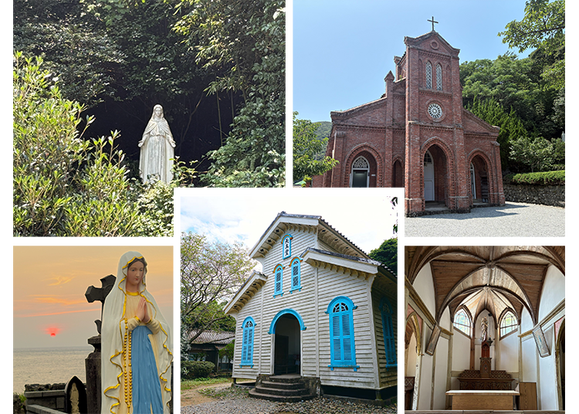
Unraveling the History of the Hidden Christians from Goto City, Nagasaki Prefecture, located in Kyushu
by: Yohei Kato
-

10 Must-Buy Cosmetics at Don Quijote (2025 Edition)
-

(12% OFF KKday Coupon) Mt. Fuji Autumn Leaves, Powder Snow & More! 15 Best Tours to Experience Japan in Fall & Winter
-
Ad

Get Your Perfect Custom Suit at GINZA Global Style PREMIUM Ginza Honten: Choose from 5,000 Fabrics, Starting at 26,400 Yen (incl. tax)!
-

The Ultimate Guide to Mitsui Outlet Parks in Japan (2025 Edition) - Popular Tax-Free Malls & Coupon Info for Travelers
by: Guest Contributor
Inspiration for Accommodations
-

Enjoy Mt. Fuji from the Comfort of Your Room! Recommended Ryokan with Mt. Fuji View
-

Stay Near the Cherry Blossoms! Hotels for Cherry Blossom Viewing in Tokyo
-

Family-Friendly Hotels with Free Shuttle to Disneyland: Convenient Access for a Magical Stay
-

Top Ranked Hakone Hotels with Mt. Fuji View: Enjoy Stunning Scenery from Your Private Space
-

Convenient Tokyo Hotels with Airport Shuttle: Ideal for Families and Heavy Luggage
-

Stunning Tokyo Tower View Hotels: Enjoy Spectacular Scenery from Your Private Space
-

Convenient Asakusa Hotels with Kitchens: Ideal for Extended Family Visits
-

Experience Luxury: Hakone's 10 Best Five-Star Accommodations
-

Enjoy Mt. Fuji Autumn Leaves! Top Hotels Near the Popular Autumn Leaves Corridor
-

Experience Hakone Fall Foliage from Your Room with Stunning Views
-

Japanese Beauty Products, Makeup, and More: The Amazing Cosmetics Floors of 6 Department Stores in and Around Tokyo!
-

The Best of Japan: 11 Major Cities Every Traveler Should Visit
-

What to Pack for Japan: 8 Essential Things for a Hassle-Free Trip
-

Secrets to Shopping in Japan: Guide to Annual Sales in Japan & Where to Shop
by: Miyu Shimada
-

Popular 2021 Hit in Japan! 5 'Oshi' Goods You Can Buy at 100-yen Shops
by: Naho Jishikyu
-

Complete Guide to Shinjuku Station: Find the Shortest Route and Access to Your Destination
- #best ramen tokyo
- #what to buy in ameyoko
- #what to bring to japan
- #new years in tokyo
- #best izakaya shinjuku
- #things to do tokyo
- #japanese nail trends
- #what to do in odaiba
- #onsen tattoo friendly tokyo
- #daiso
- #best sushi ginza
- #japanese convenience store snacks
- #best yakiniku shibuya
- #japanese fashion culture
- #best japanese soft drinks



















